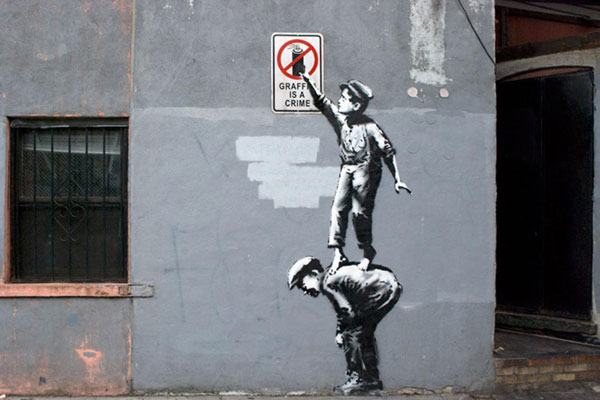
Whether you think graffiti can be considered fine art, or simply a form of vandalism, there’s no denying the skill and creativity involved. Many street artists have even made successful transitions into fine art galleries, selling their creations for hundreds of thousands of dollars.
The power of street artists lies in their ability to seamlessly communicate their message in the most unforgiving of environments.
Here are three of the most notable street artists and their enticing work:
Banksy
As ironic as it sounds, Banksy is probably the most well known anonymous street artist there is.
The british graffiti artist, whose identity remains unknown even 20 years after bursting onto the scene, has developed a highly devoted subculture of followers. What sets his work apart is its controversial nature that deals with political and anti-authoritarian subject matter.
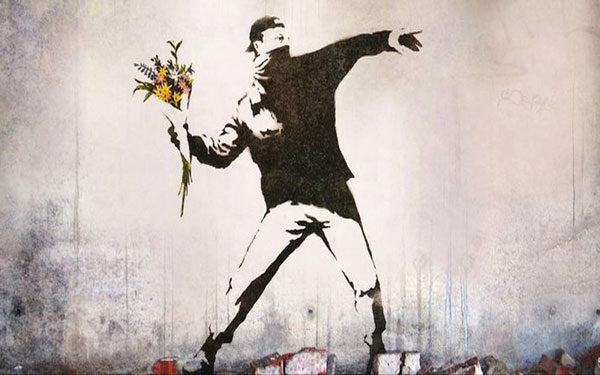 (Image source: www.artstradamagazine.com)
(Image source: www.artstradamagazine.com)
His political views and artistic style were heavily influenced by French graffiti artist, Blek le Rat. Similar to Blek le Rat’s work, Banksy adopted the method of using stencils.
In 2000, he began using stencils to accelerate the pace of his work and has since developed a distinctive style, with many of his works going viral around the world and internet. His stencils are multi-layered, combined with other sources of media such as spray paint. He also often incorporates existing street signs or objects into his artwork, using them as a means to convey his satirical message combined with a dose of dark humor.
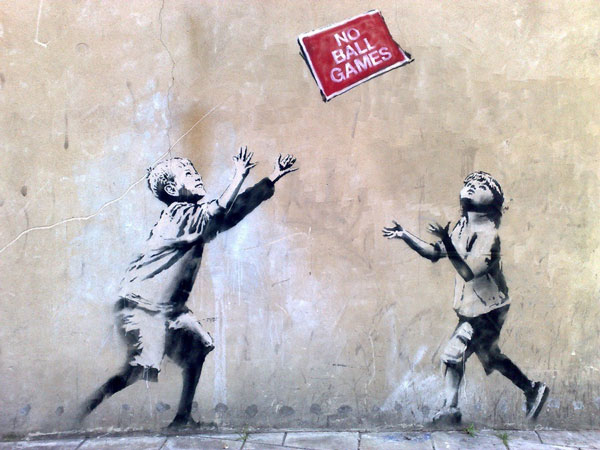
(Image source: www.unurth.com)
In his 2005 Crude Oils exhibition in London, he presented altered replicas of the works of Claude Monet, Vincent van Gogh, and Edward Hopper. However, that wasn’t all he presented— he also released 200 live rats into the gallery—definitive to his eccentric style of conveying controversial messages.
JR
As all street artists, JR exhibits his work in the streets of the world, giving him the opportunity to catch the attention of people who don’t typically visit museums.
His journey as an artist began after finding a camera in the Paris metro in 2001. He then decided to travel throughout Europe meeting and photographing street artists, and showcasing their portraits on the streets, underground areas and rooftops of Paris.
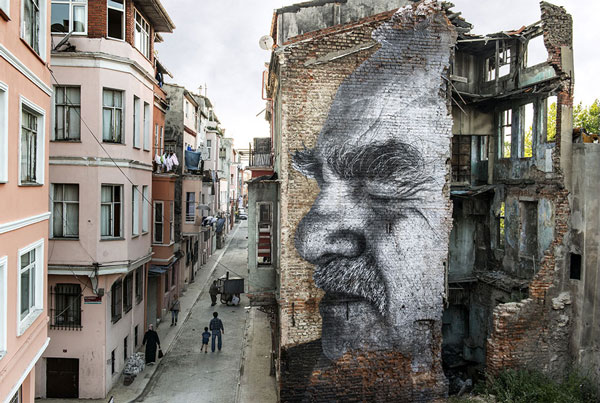
(Image source: www.qm.org.qa)
JR is known for his guerilla-style art, where he pastes giant images on buildings, trains and bridges, forcing people to view them. He often travels to distant and dangerous locations, such as slums or favelas, and infiltrates the communities, turning the members into collaborators and participants in his works. His portrait style utilizes a 28mm wide-angle lens, which he uses to get up close and personal in his subjects’ faces. This results in images that are raw, unguarded, humorous, soulful, and that capture the true spirit of the individuals who typically go unseen. In this way, he forces the public to come face to face with what they wish not to see, or have largely ignored until now.
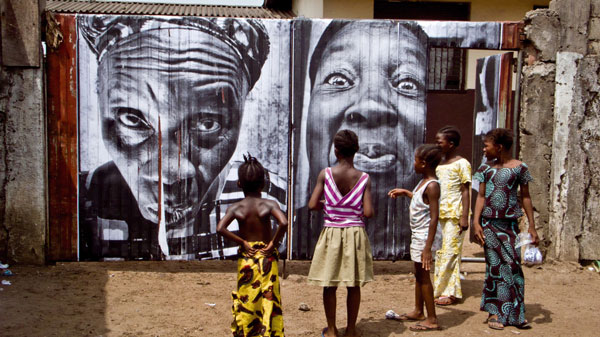
(Image source: www.huffingtonpost.com)
JR’s project Women Are Heroes gained international recognition for depicting women “dealing with the effects of war, poverty, violence, and oppression”. The women featured were from Rio de Janeiro, Phnom Penh, Delhi and several cities in Africa. And, after being awarded with the TED prize in 2011, he took this concept one step further with his ambitious project Inside Out.

(Image source: www.lazinc.com)
Inside Out is a global participatory art project where JR invites the entire world to share their portraits and transform messages of personal identity into publicly displayed art. As of December 2016, over 320,000 people from over 139 different countries took part in the collaborative project—either through mail or gigantic photo booths that were installed in museums and streets all the way from Times Square to Fukushima.
(Image source: www.wsj.com)
Eduardo Kobra
Eduardo Kobra is a Brazilian muralist who is responsible for some of the most impressive works of public art.

(Image source: www.designboom.com)
His murals are large, colorful and hyper-realistic and can be seen on buildings and walls throughout the streets of his hometown, Sao Paulo. His style is distinct in its colorful patterns which are seemingly projected onto very detailed paintings.
Kobra also creates unique three-dimensional chalk paintings that when viewed from the right angle seem to pop out of the sidewalk or street they were painted on.
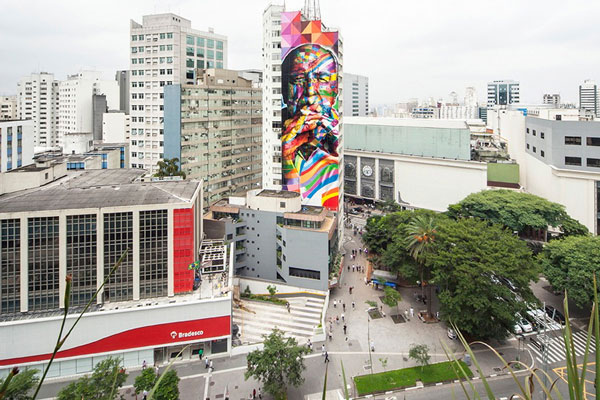
(Image source: www.designboom.com)
His latest Sau Paulo project was a 180-foot portrait of the late Brazilian architect Oscar Niemeyer. He began working on the colossal project on January 14th, 2013 and later solicited the help of four other street artists to complete the piece. The impressive portrait graces an entire side of a skyscraper building on the busy Paulista avenue in Sao Paulo.
Retna
Los Angeles based graffiti artist and muralist, Retna has an impressive collection of murals characterized by his exotic lettering that resembles ancient hieroglyphics, Asian calligraphy and other forms of classical scripts.
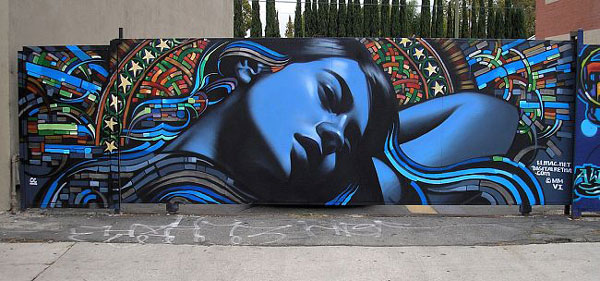
(Image source: www.creativityfuse.com)
His style often involves placing his signature lettering and colorful patterns around realistic portraits. Most of his work can be see around the streets of Los Angeles an cities from New York and Miami to Taipei and Barcelona.
Retna also enjoys plenty of mainstream success after selling his artwork to celebrities such as Usher and exhibiting in many gallery shows.
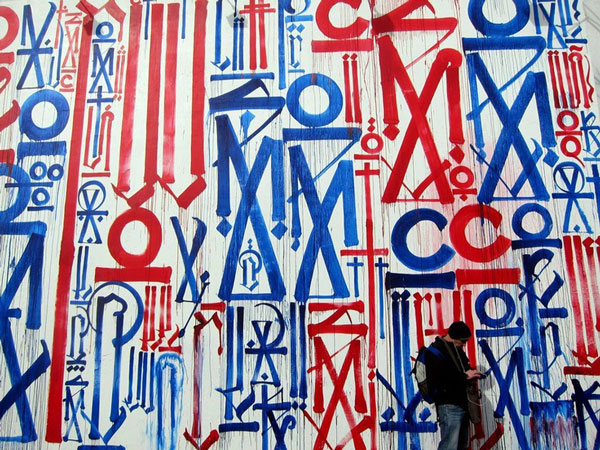
His 2001 Hallelujah World Tour, which debuted at a pop up shop in New York City, incorporated elements of anthropology and historical academia. The traveling show was set up in a 10,000 square foot exhibition space and yet still felt crowded. The exhibit gave off a feeling of mystery, monastery and motion with the distinctive monochromatic paintings featuring splashes of red over white, black and silver text.
David Choe
In stark contrast to Banksy and JR, street artist David Choe enjoys showing off his work and who he is. The flamboyant graffiti artist is a resident of Los Angeles, graphic designer and muralist who is most famous for requesting company stock as payment from Facebook for painting a mural at their headquarters. He subsequently became a millionaire after selling that stock and hasn’t looked back since.
 (Image source: www.davidchoe.com)
(Image source: www.davidchoe.com)
Choe’s work can be seen on film sets, album covers, and scattered through the streets of Los Angeles. His more formal murals are created using multiple layers and colorful shading to give it his unique style.
His artistic style is often playful, flamboyant, rambunctious and full of humor—but that’s not to say each piece lacks an emotional interpretation. In his most recent invite-only exhibition, The Choe Show, viewers were left feeling a mix of emotions after experiencing an intimate and unique connection. The show took place at secret Koreatown location and required participants to go through an extensive application process before attending. Guests were forbidden to come with friends they already knew, which forced everyone to befriend complete strangers.
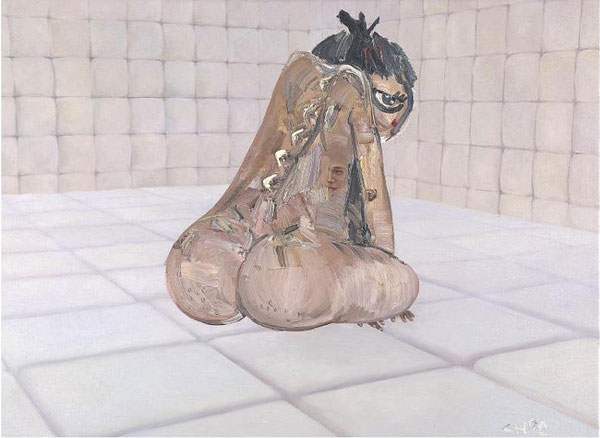
(Image source: www.laweekly.com)
In signature Choe fashion, guests were instructed before the show not to: “BRING YOUR PHONE, CAMERA, ELECTRONICS OR MONEY. DON’T EAT, MASTURBATE, WATCH PORN, DRINK OR DO DRUGS FOR 12 HOURS BEFORE COMING TO THE CHOE SHOW – USE THE RESTROOM BEFORE YOU COME.”
So, whether you prefer your fine art exhibited in galleries and museums or on the streets of your home city, there’s no denying the genius that street artists possess. Presented with the challenges of exhibiting in open air, they create unprecedented works that are full with meaning and powerful messages only they know how to convey.

